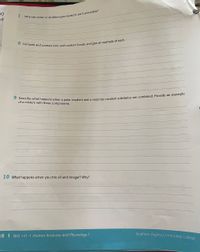
thank you for answeing the fisrt three question. Here are the other questions

7)
Answer -
Water or distilled water tested in each procedure they are both used because regular water atoms and molecules have active charges while distilled water has no charge. They react differently.
So due to this reason water or distilled water tested in each procedure.
8)
Answer -
Ionic bond -
Ionic bonding is a type of chemical bonding that involves the electrostatic attraction between oppositely charged ions, or between two atoms with sharply different electronegativities,
Ionic bond is a bond between metal and nonmetal with a transfer of an electron from a metal to a nonmetal. Electrostatic force arises between charged atoms called ions, which are surrounded by oppositely charged particles. Ionic bond is the strongest. The example of an ionic bond is a bond in sodium chloride.
Covalent bond -
A covalent bond is a chemical bond that involves the sharing of electron pairs between atoms. These electron pairs are known as shared pairs or bonding pairs, and the stable balance of attractive and repulsive forces between atoms, when they share electrons, is known as covalent bonding
Covalent bond is a bond between nonmetals sharing their electrons, which become common for two different atoms. The example of a covalent bond is a double covalent bond in a molecule of oxygen
compare and contrast ionic bonds and covalent bonds -
1.In covalent bonds, atoms share electrons, whereas in ionic bonds atoms transfer electrons.
2The reaction components of covalent bonds are electrically neutral, whereas for ionic bonds they are both charged.
3.Covalent bonds are formed between two non-metals, whereas ionic bonds are formed between a metal and non-metal
Trending nowThis is a popular solution!
Step by stepSolved in 3 steps

- For each compound below, draw in all missing lone pairs and indicate whether each lone pair is delocalized or localized. Then, use that information to determine the hybridization state for each atom that has a lone pair. Hint: allylic lone pairs are delocalized and do not count towards the steric number.arrow_forwardg. h. wit $ Ph Br li NaOCH, CH₂OH (cold, short time) 1. LDA 2 Br OCH₂ & 1. NaOCH₂ CH₂OH 2. BrCH₂CH₂CH₂ 3. H+, H₂O, heat 1. PPh 2. BuLi 3. NaOEt OEt EtOH NaOCH, CH₂OH (warmup, long time)arrow_forwardCI 7.arrow_forward
 ChemistryChemistryISBN:9781305957404Author:Steven S. Zumdahl, Susan A. Zumdahl, Donald J. DeCostePublisher:Cengage Learning
ChemistryChemistryISBN:9781305957404Author:Steven S. Zumdahl, Susan A. Zumdahl, Donald J. DeCostePublisher:Cengage Learning ChemistryChemistryISBN:9781259911156Author:Raymond Chang Dr., Jason Overby ProfessorPublisher:McGraw-Hill Education
ChemistryChemistryISBN:9781259911156Author:Raymond Chang Dr., Jason Overby ProfessorPublisher:McGraw-Hill Education Principles of Instrumental AnalysisChemistryISBN:9781305577213Author:Douglas A. Skoog, F. James Holler, Stanley R. CrouchPublisher:Cengage Learning
Principles of Instrumental AnalysisChemistryISBN:9781305577213Author:Douglas A. Skoog, F. James Holler, Stanley R. CrouchPublisher:Cengage Learning Organic ChemistryChemistryISBN:9780078021558Author:Janice Gorzynski Smith Dr.Publisher:McGraw-Hill Education
Organic ChemistryChemistryISBN:9780078021558Author:Janice Gorzynski Smith Dr.Publisher:McGraw-Hill Education Chemistry: Principles and ReactionsChemistryISBN:9781305079373Author:William L. Masterton, Cecile N. HurleyPublisher:Cengage Learning
Chemistry: Principles and ReactionsChemistryISBN:9781305079373Author:William L. Masterton, Cecile N. HurleyPublisher:Cengage Learning Elementary Principles of Chemical Processes, Bind...ChemistryISBN:9781118431221Author:Richard M. Felder, Ronald W. Rousseau, Lisa G. BullardPublisher:WILEY
Elementary Principles of Chemical Processes, Bind...ChemistryISBN:9781118431221Author:Richard M. Felder, Ronald W. Rousseau, Lisa G. BullardPublisher:WILEY





